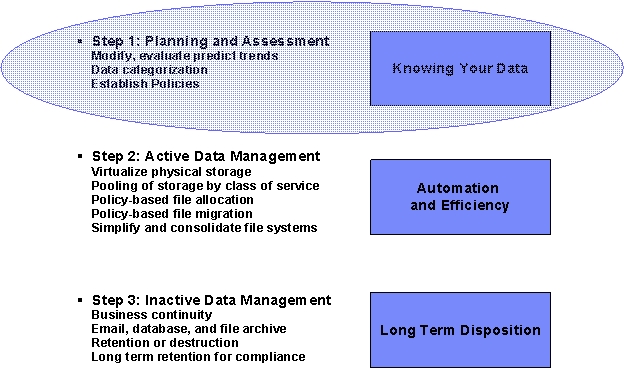| Tool Mentor: TPC – Control, Deploy and Maintain Data |
 |
|
| Related Elements |
|---|
ContextTool mentors explain how a tool can perform tasks, which are part of ITUP processes and activities. The tasks are listed as Related Elements in the Relationships section. You can see the details of how processes and activities are supported by this tool mentor, by clicking the links next to the icons: DetailsToday, more customers are looking for ways to organize their corporate information, manage it efficiently and establish service levels for different classes of storage. Productivity Center for Data can assist with all three elements. Productivity Center for Data is designed to provide autonomic computing capacity management through its file-system-extension capability. Through monitoring, Productivity Center for Data detects when a user-defined threshold has been reached, and extend the file system, to help prevent a potential outage. TotalStorage Productivity Center for Data provides:
The Basic ProblemStorage needs are rising and the challenge of managing disparate storage systems is growing. Many business environments see a storage growth rate of over 50% per year. Business applications running across multiple operating systems are driving this growth. To provide value to the business these applications must be highly available. The storage resources that these applications depend on are typically spread across storage systems from different vendors each with different costs, performance characteristics and unique management interfaces. The goal of Data Lifecycle Management is to add or reallocate storage in a way that ensures application availability while matching the cost of storage to the value of data. Logical Steps To Implementing Data Lifecycle Management
How TPC for Data Helps Solve the ProblemIBM® TotalStorage Productivity Center for Data helps in the Planning and Assessment phase of Data Lifecycle Management by allowing users to identify, evaluate, control, and predict your storage assets. TPC can "identify a baseline view of your storage environment and answer questions such as 1) What is your current utilization, 2) Do you have allocated, but unused database space, and 3) Which users are consuming the most space? TPC for Data also helps users "evaluate storage resources by conducting wasted space analysis, file and directory level analysis, and uncovering orphan, obsolete and misused files. TPC for Data provides "control of your storage resources by allowing you to establish centralized alerts, set automated responses, and implement quotas. Finally, you can "predict future growth and at-risk situations and identify the fastest growing users, file systems and database tables. By establishing a base understanding of your storage environment, with an emphasis on discovering areas where simple actions can deliver rapid return on investment. TPC for Data plays a critical role in Data Lifecyle Management. Methodology for Space Reclamation - A Key Component to "Knowing Your Data"The storage pyramid was developed by IBM Tivoli® Brand Services, Development, and a large insurance customer. The idea behind the pyramid is to work from a base of all raw storage, then use TPC to determine places where raw storage is lost - either to system overheads like RAID or operating systems, or to operational losses, such as unformatted space, unallocated space, etc. The goal is to optimize and track operational losses through measurement and analysis.
For More InformationFor more information about this tool, click on the link for this tool at the top of this page. |
©Copyright IBM Corp. 2005, 2008. All Rights Reserved. |

